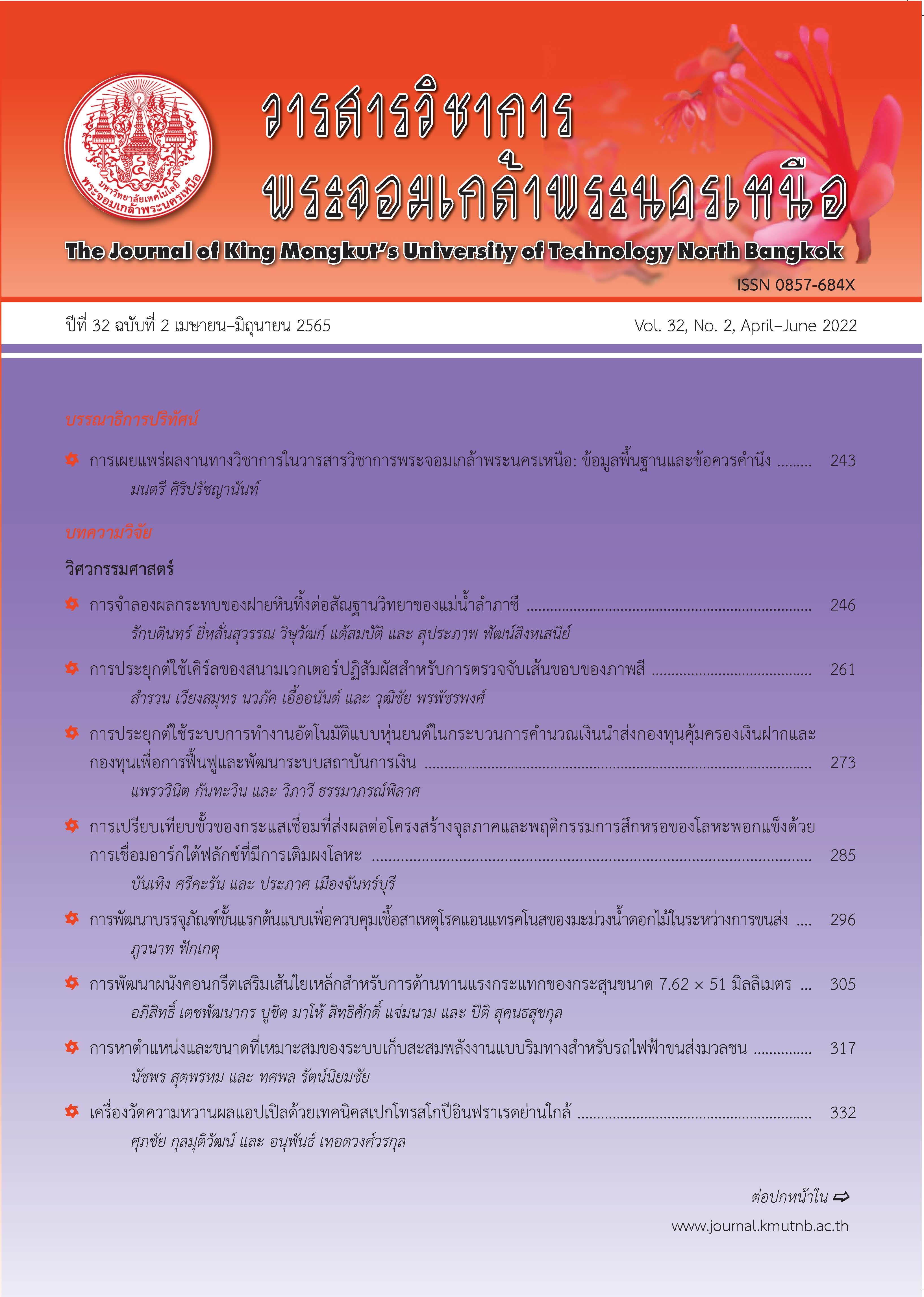การเปรียบเทียบประสิทธิภาพวิธีการประมาณค่าสูญหายของตัวแปรตอบสนองสำหรับแผนแบบแฟกทอเรียล 3 ปัจจัยในบล็อกสมบูรณ์เชิงสุ่ม
Main Article Content
บทคัดย่อ
การวิจัยครั้งนี้มีวัตถุประสงค์เพื่อเปรียบเทียบประสิทธิภาพวิธีการประมาณค่าสูญหายของตัวแปรตอบสนองสำหรับ แผนแบบแฟกทอเรียล 3 ปัจจัยในบล็อกสมบูรณ์เชิงสุ่ม 4 วิธี คือ วิธีค่าคาดหวังสูงสุด (Expectation Maximization) วิธีค่าทดแทนพหุ 1 (Multiple Imputation 1) วิธีค่าทดแทนพหุ 2 (Multiple Imputation 2) และวิธีเคเนียร์เรสเนเบอร์อิมพิวเทชัน (K-Nearest Neighbor Imputation) ซึ่งวิธีค่าทดแทนพหุ 1 และวิธีค่าทดแทนพหุ 2 จะแตกต่างกันที่วิธีการที่นำมาใช้ในการคำนวณ ทั้งนี้จำลองข้อมูลด้วยเทคนิคมอนติคาร์โล จำนวน 108 สถานการณ์ และ ทำการทดลองซ้ำในแต่ละสถานการณ์ 2,000 รอบ กำหนดให้แต่ละปัจจัยมีจำนวน 3, 4 และ 5 ระดับ และมีจำนวนบล็อกเท่ากับ 3 บล็อก ข้อมูลมีการสูญหายแบบสุ่ม ร้อยละการสูญหายของข้อมูลเท่ากับ 5 และ 10 และความแปรปรวนของค่าสังเกตเท่ากับ 25 และ 625 โดยเกณฑ์ที่ใช้ในการเปรียบเทียบประสิทธิภาพ คือ ค่าประมาณความคลาดเคลื่อนกำลังสองเฉลี่ย จากการศึกษาพบว่าวิธีเคเนียร์เรสเนเบอร์อิมพิวเทชันให้ค่าประมาณความคลาดเคลื่อนกำลังสองเฉลี่ยต่ำที่สุดในทุกสถานการณ์ที่ทำการศึกษา ดังนั้นวิธีเคเนียร์เรสเนเบอร์อิมพิวเทชันให้ประสิทธิภาพสูงสุดในทุกสถานการณ์ที่ทำการศึกษา
Article Details

อนุญาตภายใต้เงื่อนไข Creative Commons Attribution-NonCommercial-NoDerivatives 4.0 International License.
บทความที่ลงตีพิมพ์เป็นข้อคิดเห็นของผู้เขียนเท่านั้น
ผู้เขียนจะต้องเป็นผู้รับผิดชอบต่อผลทางกฎหมายใดๆ ที่อาจเกิดขึ้นจากบทความนั้น
เอกสารอ้างอิง
B. Chomtee, “Factorial designs,” in Statistical Experimental Design: Theory and Analysis by Using SAS Software. Bangkok: Department of Statistics, Faculty of Science, Kasetsart University, 2013 (in Thai).
R. J. A. Little and D. B. Rubin, Statistical Analysis with Missing Data, 2nd ed. New York: John Wiley and Sons, 2002.
P. Damrongsuttipong, “A comparison of missing value estimation methods for randomized complete block design,” M.S. thesis, Department of Statistics, Faculty of Commerce and Accountancy, Chulalongkorn University, 2003 (in Thai).
S. Kannika, “A comparison of missing value estimation methods for latin square design,” M.S. thesis, Department of Statistics, Faculty of Commerce and Accountancy, Chulalongkorn University, 2006 (in Thai).
W. Sriduangchot, “A study on the efficiency of missing data estimation methods for two factors factorial experiment in randomized complete block design,” M.S. thesis, Department of Educational Research and Statistics, Faculty of Education, Srinakharinwirot University, 2013 (in Thai).
E. C. Lovelyn, “Estimation of missing values in replicated factorial experiment,” M.S. thesis, Department of Mathematics, Faculty of Physical Sciences, Ahmadu Bello University, 2014.
A. P. Dempster, N. M. Laird, and D. B. Rubin, “Maximum likelihood from incomplete data via the EM algorithm,” Journal of the Royal Statistical Society: Series B (Methodological), vol. 39, no. 1, pp. 1–38, 1977.
D. B. Rubin, Multiple Imputation for Nonresponse in Surveys. New York: John Wiley and Sons, 1987.
S. Sinharay, H. S. Stern, and D. Russell, “The use of multiple imputation for the analysis of missing data,” Psychological Methods, vol. 6, no. 4, pp. 317–329, 2001.
M. M. Deza and E. Deza, Encyclopedia of Distances. New York: Springer, 2009.
P. Jonsson and C. Wohlin, “An evaluation of k-nearest neighbur imputation using likert data,” in Proceedings of the Software Metrics, 2004, pp. 108–118.
R. O. Duba and P. E. Hart, Pattern Classification and Scene Analysis. New York: John Wiley and Sons, 1987.
K. Chomboon, P. Chujai, P. Teerarassamee, K. Kerdprasop, and N. Kerdprasop, “An empirical study of distance metrics for k-nearest neighbor algorithmz,” in Proceedings of the 3rd International Conference on Industrial Application Engineering, 2015, pp. 280–285.

